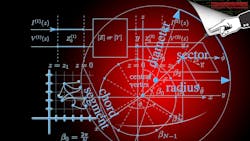Legislators Propose Rounding Pi to Just 3 Alone
Download the entire collection of April 1st articles in PDF format.
From April 1st, 2021 @Evaluation Engineering
A group of California lawmakers is working on a bill that stipulates the well-known numerical constant π (Greek letter pi), which defines the ratio of the circumference of a circle to its diameter, be set to a single-digit value of 3 for all texts, tests, and projects in primary, middle school, high school, as well as most college courses. They maintain that this would reduce stress on students who are grappling with many uncertainties, including those caused by the pandemic.
“Setting pi equal to 3 will avoid the need for students to struggle over whether they should use 3, 3.1, 3.14, or even more digits,” offered one source as rationale. ”Let’s be honest, there’s no need to go beyond 3 for most applications, so the use of more digits of that irrational number is, well, not rational. Also, where do you tell the student to stop? Some students will become trapped by worrying about the endless string of digits with which they are dealing.”
While pi would be set at 3 for pre-college students, the proposed bill further mandates that the 3 value also be used by all non-STEM (science, technology, engineering, math) college students. At the same time, students majoring in STEM disciplines can be instructed to use as many digits as the course leader feels appropriate, from the popular 3.14 through 3.14159, or even more. It specifically doesn’t prevent professionals such as engineers, scientists, and architects from using as many digits as they feel are needed.
Some of the proponents further argue for the single-digital value by saying that using more digits implies that some figures are “more significant” than others and thus sends a wrong message, in that all digits should be treated with equivalent significance. As one proponent says, “After all, who can say that the fifth digit after the decimal point—for pi, that’s a ‘9’—is truly less significant than the fourth one, a “5?” By staying with just 3 alone, we avoid the need to be judgmental.”
To further bolster their case, the legislators point out that use of 3 for pi has precedent in the King James Bible (First Kings, chapter 7, verses 23 and 26): "And he [Hiram] made a molten sea, ten cubits from the one rim to the other it was round all about, and...a line of thirty cubits did compass it round about....And it was a hand breadth thick...." along with a very similar text in 2 Chronicles 4:2. Therefore, the use of pi as equal to just 3 alone is a time-tested, reasonable approximation that has been used successfully for thousands of years.
About the Author

Bill Schweber
Contributing Editor
Bill Schweber is an electronics engineer who has written three textbooks on electronic communications systems, as well as hundreds of technical articles, opinion columns, and product features. In past roles, he worked as a technical website manager for multiple topic-specific sites for EE Times, as well as both the Executive Editor and Analog Editor at EDN.
At Analog Devices Inc., Bill was in marketing communications (public relations). As a result, he has been on both sides of the technical PR function, presenting company products, stories, and messages to the media and also as the recipient of these.
Prior to the MarCom role at Analog, Bill was associate editor of their respected technical journal and worked in their product marketing and applications engineering groups. Before those roles, he was at Instron Corp., doing hands-on analog- and power-circuit design and systems integration for materials-testing machine controls.
Bill has an MSEE (Univ. of Mass) and BSEE (Columbia Univ.), is a Registered Professional Engineer, and holds an Advanced Class amateur radio license. He has also planned, written, and presented online courses on a variety of engineering topics, including MOSFET basics, ADC selection, and driving LEDs.
